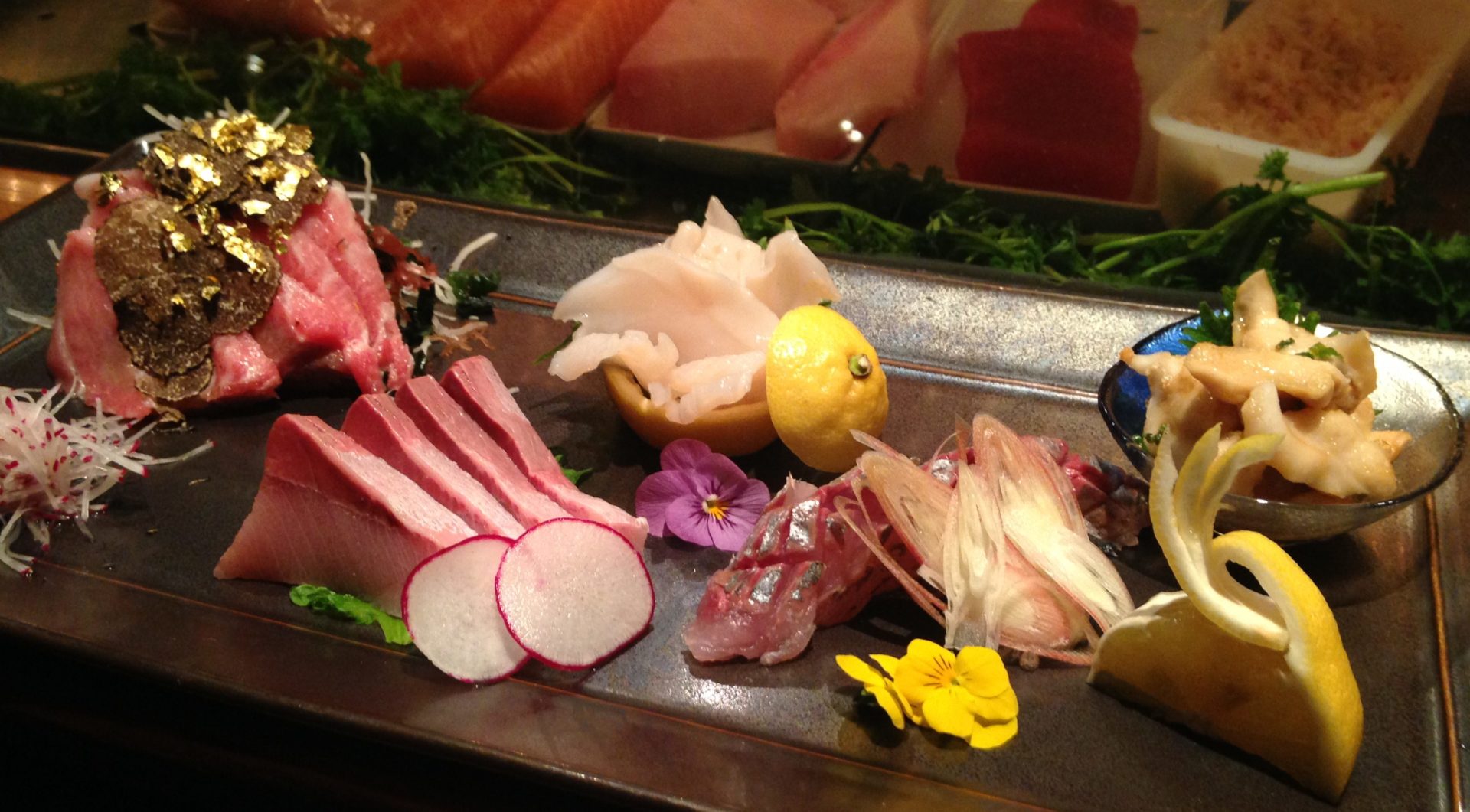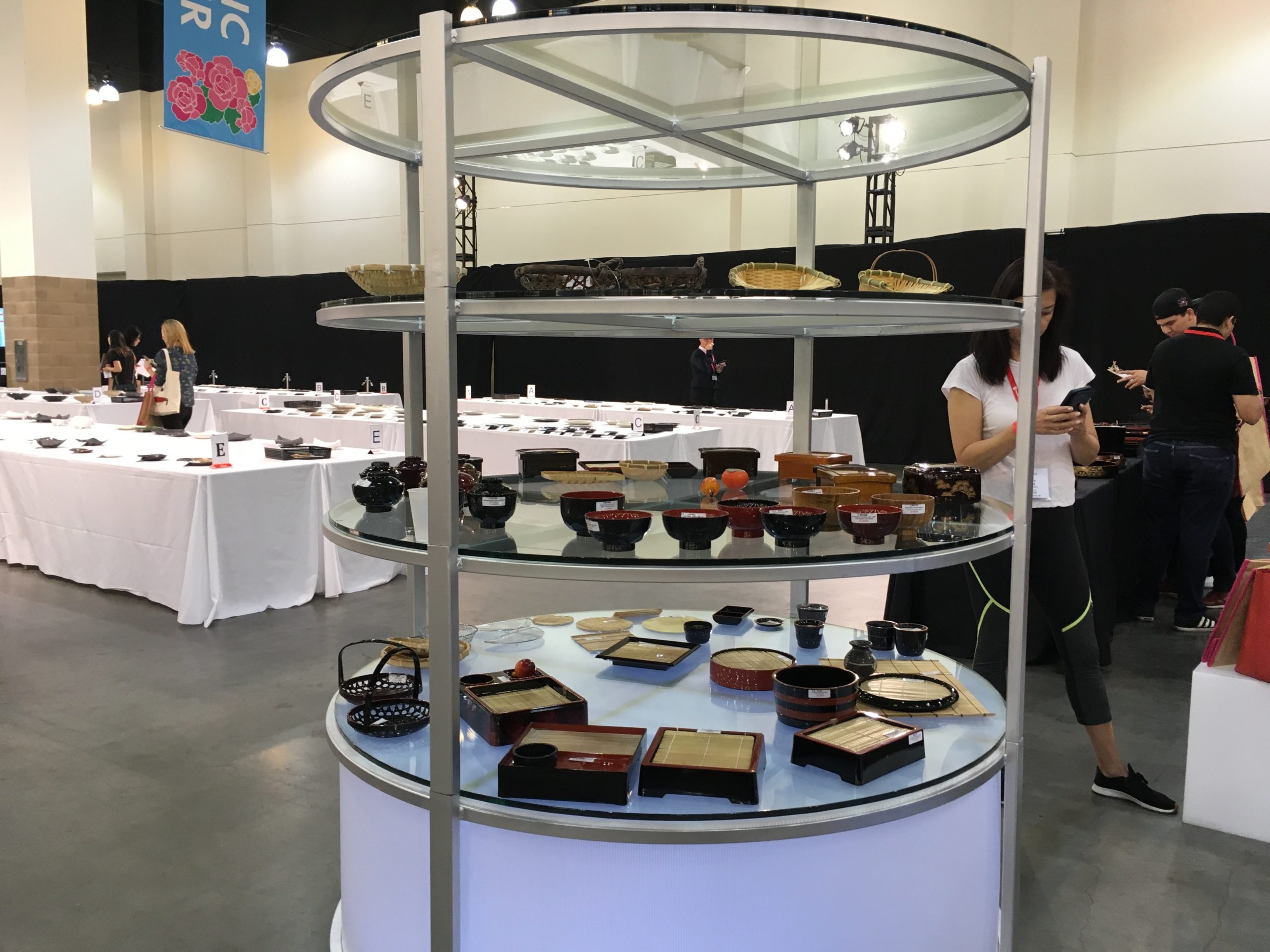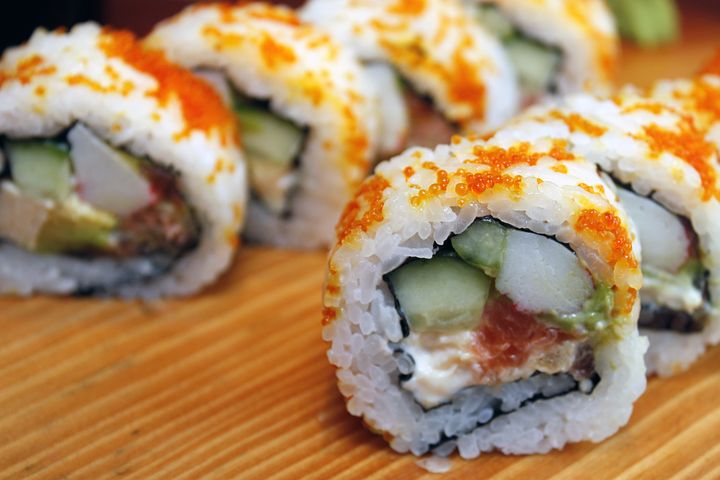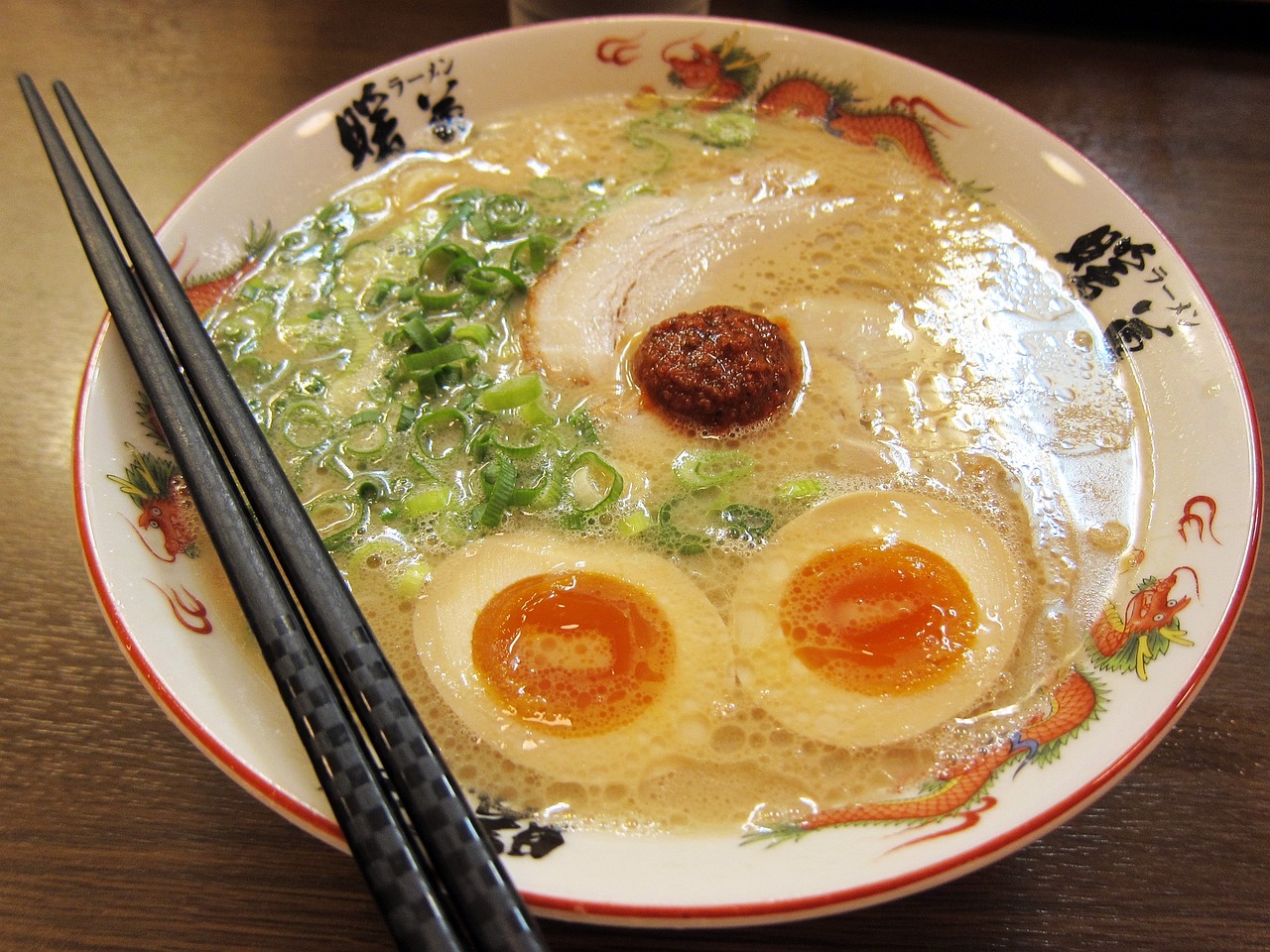 View Winners →
View Winners → A Dash of Japanese Culinary Philosophy in a Simple Bowl of Ramen Noodles


Sushi Roku in Pasadena’s Old Town serves only the freshest fish and highest quality food. Head Sushi Chef Manzo Kitaura creates beautiful sashimi plates. – Photo by May S. Ruiz / Beacon Media News
By May S. Ruiz
We know that Californians have developed sophisticated palates when sushi and sashimi restaurants are as ubiquitous as eateries serving standard American fare. In the San Gabriel Valley, Japanese food is so mainstream that ramen noodle joints can be found at every strip mall.
So how did ramen and sushi become something akin to staple dining options? Well, we can say that it’s mostly because of the large Asian population in the area. There was a time, however, when this wasn’t the case, and we owe our appreciation for raw seafood to a very enterprising immigrant who introduced sushi to Los Angeles.
Noritoshi Kanai, the former chairman of Los Angeles Mutual Trading Co., Inc. (Mutual Trading), may have singlehandedly been responsible for bringing sushi to our local dining scene. It wouldn’t be an exaggeration to say that sushi eating in this country is intrinsically linked with the company.
Leading up to Mutual Trading’s 30th Annual Japanese Food & Restaurant Expo on September 22 at the Pasadena Convention Center, Atsuko Kanai, Executive Vice President, provides a very enlightening and fascinating history lesson in the sushi business in Southern California.
Atsuko says, “This trade show grew organically. We began as a Japanese food wholesaler and, as the business expanded, we started carrying specialty items for chefs like chinaware and professional knives specifically for Japanese food preparation. Our first show, in 1989, was a modest chinaware sale held in our office parking lot.

Mutual Trading’s 30th Annual Expo featured Japanese serving ware like sashimi/sushi platters and soup bowls, among other things. – Photo by May S. Ruiz / Beacon Media News
“We continued holding our Japanese Restaurant Shows for 24 years at our own site using the warehouse area and the parking lot. Our staff designed and produced the event – from the theme that changed yearly, to product selection, to seminar highlights – and even procured special items aimed at filling customers’ needs.
“The corporation currently has 500 employees, with ten locations spanning the United States, Lima (Peru) and Tokyo (Japan). It began as a small enterprise in 1926 in Los Angeles when a group of ten Japanese businessmen in Little Tokyo formed a co-op to create an import channel for basic food commodities from Japan, mainly dried and canned. Back then, products were shipped in cargo freighters, taking months to travel across the Pacific.”
“In the 1960s Mutual Trading decided to focus on the foodservice trade and it has since become our forte,” continues Atsuko. “Our portfolio consists of specialty foods, chilled and frozen items, alcoholic beverages, and specialized restaurant equipment. And to help the industry continue growing and improving, we also offer educational services through our sushi and sake schools.
“Mr. Kanai’s involvement with the company began in 1951 when he opened Mutual Trading in Japan, serving as the export arm and procurement outfit for products headed for sales at Los Angeles Mutual Trading. He then immigrated to the U.S. in 1964 to manage LA Mutual, becoming president in 1976. He passed the position to the current president Kosei Yamamoto in 2011. The corporation is now a conglomerate under a publicly-traded company in Japan with Takara Shuzo International Co., Ltd. as major stockholder.”
Sushi’s rise as a gustatory star is as captivating a story as the Japanese way of life itself. It was during the 1964 Summer Olympics in Tokyo, that Japanese culture and cuisine gained international prominence.
It was also then that Japanese industries – the Toyotas and the Panasonics – were starting to establish their U.S. headquarters in Southern California. That brought Japanese expatriates into the area, all yearning for foods from back home.
Atsuko relates “Mr. Kanai and his business consultant, a Jewish-American gentleman named Harry Wolff, Jr., were also trying to figure out what items they could next bring into the country. They traveled all over Asia – the Philippines, Malaysia, Singapore – but those trips yielded no viable leads.

A selection of sushi items. – Courtesy photo
“One night, on a dare, Mr. Kanai took Mr. Wolff to a sushi shop behind their hotel in Ginza. To his surprise, the American ate every raw fish they were served. A week later, Mr. Kanai was presented a large bill from the sushi restaurant. Unbeknownst to him, Mr. Wolff had been visiting ‘his’ sushi man every evening before dinner to have his fill of sushi as appetizers.
“Not only was Mr. Wolff sold on sushi’s fresh appeal, he also believed Japanese chefs were great entertainers as they prepared the food in front of diners. He thought they were worldly – it didn’t matter that they really couldn’t speak English well – they had great charm and showmanship. He thought it was a great concept to take back to the U.S.
“Mr. Kanai took Chef Saito and his wife with him to Los Angeles to open the first sushi bar in America, in Little Tokyo, on the second floor of the Kawafuku Restaurant. Within a year the couple had made a small fortune and, upon returning to Japan, opened Shinnosuke Sushi, their very own restaurant in the fashionable Ginza district – a feat unheard of for such a young man to have achieved because sushi apprenticeship usually took a couple of decades at that time. News of his incredible accomplishment quickly spread, inspiring sushi chefs-in-training, with much encouragement from Saito, to head to America to become sushi pioneers.”
That was how, in 1965, edomae-style sushi first landed on American soil. Thereafter, young and ambitious sushi chefs came in droves to U.S., built a niche business, and found success.
A shortage in fatty tuna (toro), an important component in the sushi trade, could very well have spelled disaster for any Japanese restaurant. When this unfortunate episode occurred in the late 1960s and early 1970s, an innovative chef created the California Roll using avocado as a substitute.
There is a controversy as to who really invented the California Roll with several sushi chefs being credited with it. One account has it that Chef Ichiro Mashita of Tokyo Kaikan in Little Tokyo was the first in the world to reverse-roll the dark seaweed to hide it inside the white rice.
But whoever came up with that singular idea resolved not only the fatty tuna shortage crisis but also Americans’ trepidation at eating anything black in color. It was a masterstroke of genius. The creation of the California Roll is the very epitome of truth in the adage ‘Adversity is the mother of all invention.’ Today, even diners who can’t eat raw fish order the California Roll and get the satisfaction of saying they enjoy sushi.

The popular and universally-liked California Roll. – Courtesy photo
Mutual Trading was running through an entrepreneurial spirit as well. It succeeded in the commercial frozen edamame import business in 1970. Then, in 1972, it became the first to import junmai shu, pure rice ingredient sake.
Furthermore, Mutual Trading offered benefits unprecedented then – profit sharing, stock options, and fully paid health insurance – a business-savvy move that espoused staff loyalty and ensured employment longevity.
James Clavell’s epic novel ‘Shogun’ was adapted for television and ABC aired the miniseries in 1980. It was a phenomenon among American viewers. Young people got enamored with Japanese culture and loved everything Japanese.
For a week, when the show was airing, Japanese restaurants were deserted, only to be overrun the following week by crowds of Americans queueing to eat sushi and other Japanese specialties. American entrepreneurs capitalized on the mystique of Japanese-owned restaurants as a trend and opened their sushi establishments. The renowned Teru Sushi in Hollywood was one of them.
As business evolved to attract new customers, sushi restaurants also came in various styles. California Beach in Hermosa Beach rode this tide – surf-and-sun-worshipping diners gladly waited for hours to get seated and ate sushi surrounded by much amplified rock n’ roll music. While they waited, they’d hang out on the sidewalk drinking tall bottles of Sapporo beer straight from the bottle. And that became an independent, fashionable pastime.
During Japan’s bubble economy in the 1980s, Mutual Trading brought in premium Jizake artisan micro-brewed sake priced at over six times that of domestically brewed sake. Though a tough sell at the outset, restaurateurs were educated on consumers’ appreciation for high quality products and it gained a foothold. There are now hundreds of premium brands available in America.

Various brands of sake were on display during Mutual Trading’s 30th Annual Expo. – Photo by May S. Ruiz / Beacon Media News
The beginning of the new millennium was marked by recessions and made casual dining an inevitable choice for many Americans. So a new generation of Japanese food professionals invaded the foodservice landscape in the early 2000s and brought with them other genres of Japanese food – ramen, tonkatsu, izakaya, yakitori, curry, udon and soba.
With the ascent of Japanese food in our collective consciousness, Mutual Trading’s responsibility to advance quality assurance grew. In 2003, it constructed the first super-freezer (Minus 60 degrees F) storage facility on the West Coast. This technology guarantees that seafood arrives at restaurant kitchens at the same fresh state it was when first caught.
In 2008, Mutual Trading established Miyako Sushi and Washoku School. A brainchild of the famed Chef Katsuya and Noritoshi Kanai, it not only offers instruction to aspiring sushi chefs who wouldn’t otherwise have access to proper culinary preparation, but mentoring future generations of chefs as well.
Mutual Trading opened the Sake School of America in 2010 to afford trade professionals a better understanding and enjoyment of Japanese liquors. Wine fans and master sommeliers started to take interest in learning about sake and Shochu, an unexpected but lucky outcome.
UNESCO designated the washoku traditional Japanese food as an intangible cultural heritage in 2013.
There are 35,000 Japanese restaurants all over the U.S. today and Los Angeles Mutual Trading services 3,500 of them from San Luis Obispo to San Diego. Atsuko declares, “Every sales rep excels in Japanese food knowledge, and is a skilled Sake and Shochu adviser or sommelier. We don’t just sell food from Japan, we are trained to serve as ambassadors of Japanese food culture and as their promoters in faraway regions outside of Japan. Indeed, we are the stewards and staunch protectors of Japanese tradition and way of life.”
Sushi preparation and presentation are as much an art as they are a science. Explains Atsuko, “Sushi is always made of vinegar-ed rice and a topping – the acidic seasoning aids in suppressing deterioration. Green tea, which often accompanies sushi, is also a palate cleanser between each serving of sushi.
“Well-trained, professional sushi chefs would know which direction to cut the fish and which knife to use. Without the proper knife and technique, the sashimi would be cut to a curve; with a yanagi knife, it will stand upright when plated. They would know how to present the selection in an aesthetically pleasing way – pieces would have harmonious colors, and set asymmetrically, having highs and lows. They would know which season to select a certain fish that is not contaminated with parasites.”
Mutual Trading’s contribution to the success of the Japanese dining experience is vast. Atsuko states, “We’re importers and distributors and that’s where we excel. We have over 6,000 items in our inventory which we sell to our member restaurants and proprietors. Our product development and procurement team is constantly researching, and working very closely with suppliers. There are abundant possibilities and opportunities in the U.S, and Japan, and it’s our job to help our clients run their business efficiently and profitably.”
For all that Mutual Trading does to maintain the standards of authentic Japanese cuisine, however, there are natural obstacles that make it difficult for American restaurants to exactly replicate the sushi one can eat in Japan.
“Although close, sushi here is not the same as the ones found in Japan,” Atsuko clarifies. “Japan is a small country completely surrounded by water. This makes fresh seafood available year-round, sold at the many fresh fish markets dotting the coasts. There, it’s possible to deliver fish caught in the ocean, even live, within a day. Because of climatic and migration patterns, there is an ever-changing variety of fish and shellfish at Japanese markets. Restaurants can create local and culturally based cuisine around them.
“The United States is a big country, with coastal regions east and west, and a vast land mass in between. Fresh fish delivery isn’t viable with too many miles to cover. The fishery industry here began, and is still dominated by, cooked canned tuna. Many large fish though – tuna and yellowtail – are either farmed overseas and frozen, or caught at sea and frozen. In that sense, the quality of the fish is basically the same anywhere it’s served.”

A bowl of delicious ramen noodle soup. – Courtesy photo
There is also the matter of keeping the taste of the food made here as authentic as dishes prepared in Japan.
Atsuko elucidates, “There are many factors that can change a cuisine when brought to another country. The first one that comes to mind is water. Most of Japan has soft water while California pulls hard, highly mineralized water from the Colorado River. Consider the most fundamental Japanese food ingredient dashi: soft water can extract umami essence easily, which hard water can’t do.
“Availability of ingredients is another factor. There are 47 different prefectures in Japan, with their unique micro-geographic characteristics. They individually have their locally-grown soy sauce, salt, chili peppers, miso, and vinegar to suit and enhance the distinctive taste of their regional cuisine. American restaurants are limited to what importers, like us, bring in. For instance, we carry about 100 types of soy sauce. That sounds like a lot, but there are thousands available in Japan.”
Mutual Trading’s mission is to bring the flavors of Japan to the people of the world. And while that might not be the same everywhere, there is one thing that remains constant.
“The Japanese culinary philosophy is backed by a thousand-year history and is based on highlighting the natural ingredients through minimal culinary alteration,” emphasizes Atsuko. “This philosophy is reflected in ingredient growing/harvesting, preparation techniques, tools and equipment, serving ware, and ambience. It starts from the birth of the ingredient to its consumption.”
“Two other philosophies underlie Japanese eating practice. The first one is ‘Itadakimasu,’ the mindful reverence to the food before eating it. It is Buddhist in origin and from it stems the practice of minimizing waste: eat all you take, and use the entire ingredient from top to bottom, head to tail.
“The second is ‘Omotenashi,’ the art of generous hospitality: preserving what the guest would delight in, and offering it subliminally. It’s like engaging in a thankful task, without calling attention to oneself to warrant a word of thanks. That mutual respect of giving thanks and receiving it is inherently understood. It’s so Zen-like.”
That ramen, once synonymous with the lowly ‘cup o’ noodles’ and consumed mainly by cash-strapped, dorm-dwelling college students, has been elevated to a loftier status as seen by the current craze for tonkatsu ramen, is proof that Americans’ fondness for Japanese food isn’t waning any time soon.
Sushi and sashimi, ramen and udon, with their distinctive flavors and style, have become profoundly appealing to a great many diners. That there is a Japanese culinary philosophy behind a serving of raw fish only makes eating sushi a sublimely pleasurable dining experience.









































































































